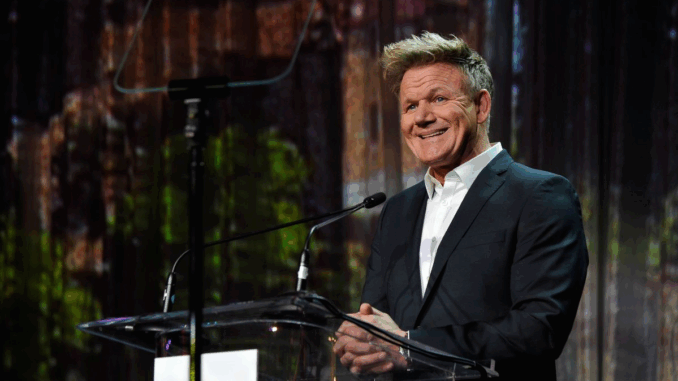
It was supposed to be the moment that put a sleepy college town dive bar on the map. A TV makeover by one of the most famous chefs in the world, Gordon Ramsay, should have meant packed tables, glowing reviews, and a future filled with clinking glasses. Instead, it triggered a slow-motion disaster that left loyal patrons angry, the owners scrambling, and the once-beloved watering hole struggling to survive.
This is the story of how a single intervention—broadcast to millions—managed to erase decades of goodwill in just a few months. And if you ask the locals, they’ll tell you: it never should have happened at all.
A Dive Bar With History—and Heart
Before Ramsay’s cameras ever rolled into town, the place wasn’t just a bar. It was a tradition. Students knew it as the cheapest hangout around: $2 beers, $1 pizza slices, and a menu that never pretended to be gourmet. Sticky floors, neon lights, mismatched bar stools—it was everything a dive bar should be.
The food wasn’t going to win awards, but it didn’t have to. People came for the atmosphere: live bands crammed into the corner stage, bartenders who knew your order before you sat down, and a crowd that mixed college kids with old regulars in a way only small-town bars can manage.
Sure, the décor was outdated. The bathrooms? Legendary—in the worst way. But that was part of the charm. And for over two decades, it worked.
Enter Gordon Ramsay
When word spread that Gordon Ramsay’s latest reality show—rumored to be 24 Hours to Hell and Back—was coming, people were curious. Was it really possible that the fiery chef could make their humble dive bar into a polished, must-visit spot? The owners thought so. They had big dreams of expanding their audience and maybe even becoming a destination for food lovers.
The filming was intense. Ramsay and his crew swept in like a hurricane, gutting the décor, overhauling the menu, and rebranding the place almost overnight.
The old neon signs? Gone. The battered bar stools? Replaced with sleek seating. The menu that offered greasy favorites at unbeatable prices? Trashed, replaced with a curated list of 10 to 12 “elevated” dishes—none of them under $15.
The Immediate Backlash
Locals didn’t just dislike the changes—they hated them.
“This wasn’t just a bar, it was part of our lives,” said one longtime customer. “Now it feels like any other overpriced restaurant.”
The price hikes were the final straw. The $2 beer special vanished. The beloved $1 pizza slice—gone forever. In its place came craft cocktails and fancy flatbreads that nobody had asked for.
People stopped coming. Not in a slow decline, but almost overnight. Even the owners admitted privately that the place was emptier than it had been in years. And this was before COVID hit.
The Show Must Go On… But at What Cost?
On TV, the transformation looked like a triumph. Ramsay’s charm, sharp critiques, and dramatic “before and after” shots made it seem like a happy ending. But off-camera, the story was different.
Regulars felt betrayed, staff morale dropped, and the new identity of the bar confused everyone. Was it still a local hangout? A high-end gastropub? A college town was never going to sustain $15 entrée prices—not when a dozen other spots served hearty meals for half that.
Some employees left. Others stuck around, hoping things might change. The owners tried promotions, happy hours, and limited-time throwbacks to the old menu, but the magic was gone.
A Familiar Pattern
If this sounds like déjà vu, it’s because it’s not the first time a Ramsay-led makeover has ended badly. Across the U.S., stories have emerged of restaurants struggling—or outright closing—after being featured on his shows.
The formula is always the same: dramatic changes made in a short time, designed for maximum TV impact. It works on-screen. It doesn’t always work in real life.
One former employee from a different Ramsay project put it bluntly: “He’s not thinking about whether these changes will work long-term. He’s thinking about making good television.”

Locals Try to Take Back Their Bar
In the months after the cameras left, the owners realized they had to act fast. They began undoing some of the changes. Prices were lowered, a few of the old menu favorites came back, and some of the décor was restored to match the bar’s original vibe.
It helped… a little. But many regulars had already found new hangouts. Once a tradition is broken, it’s hard to rebuild.
One former patron summed it up perfectly: “It’s like they took our local dive and tried to turn it into something it was never meant to be. Now it’s not that new thing, but it’s not the old place either. It’s just… lost.”
The Ramsay Effect: Blessing or Curse?
Gordon Ramsay’s shows have saved many restaurants. But they’ve also left a trail of businesses that couldn’t adapt to their new identities. The truth is, TV makeovers don’t always consider the deeper reality: the culture of a place, the regulars who keep it alive, and the community ties that can’t be priced on a menu.
In this case, the “rescue” may have done more harm than good.
The bar is still open—for now. But it’s a shadow of what it used to be. And if you ask the people who were there before Ramsay came to town, they’ll tell you without hesitation: the makeover destroyed everything they loved about it.
